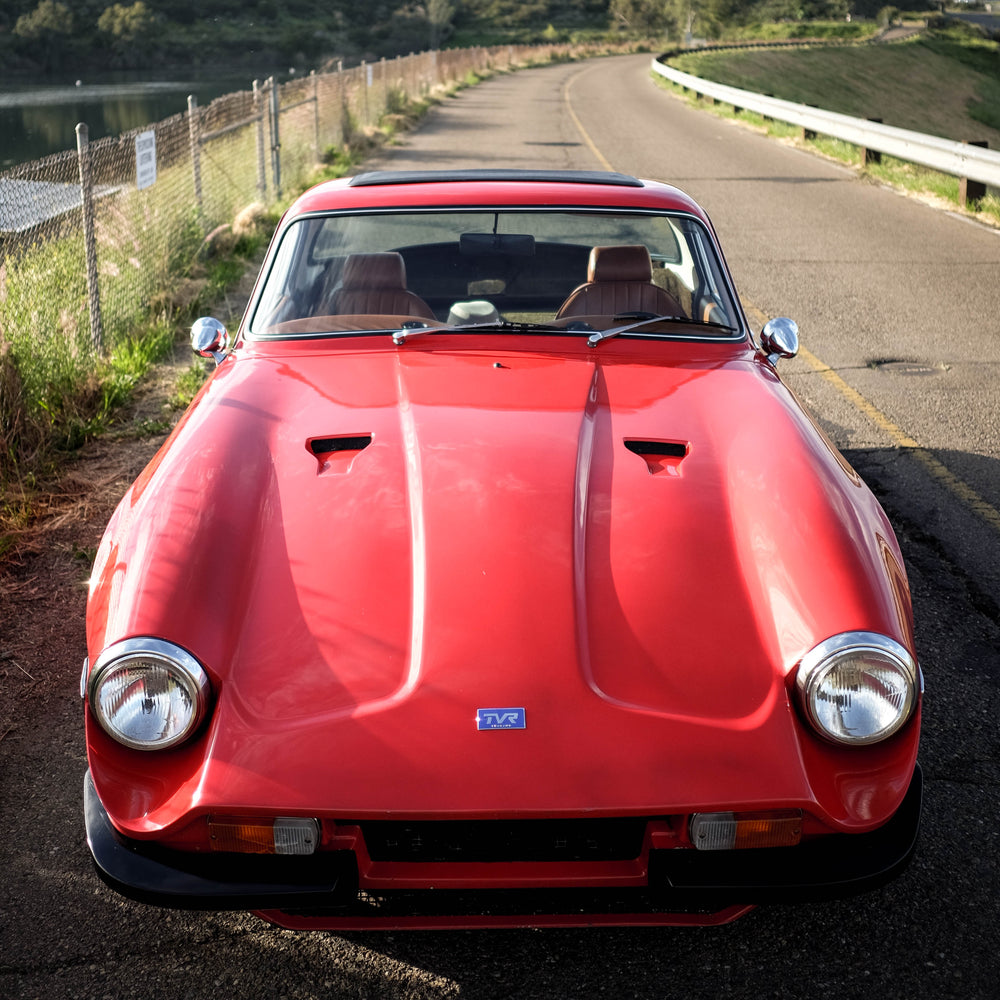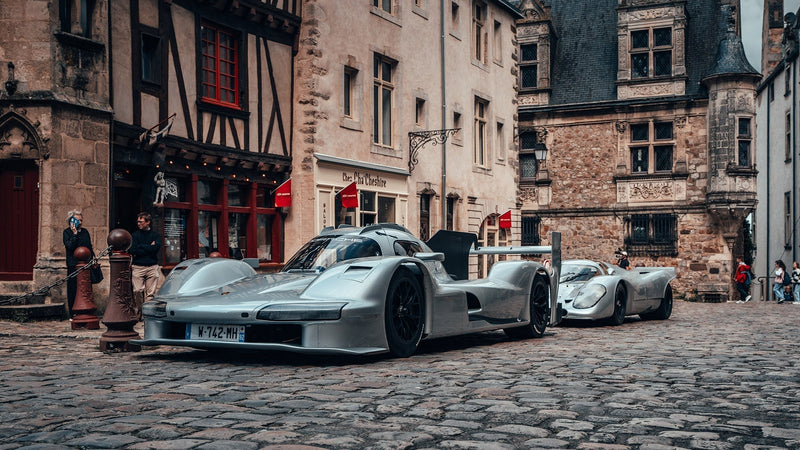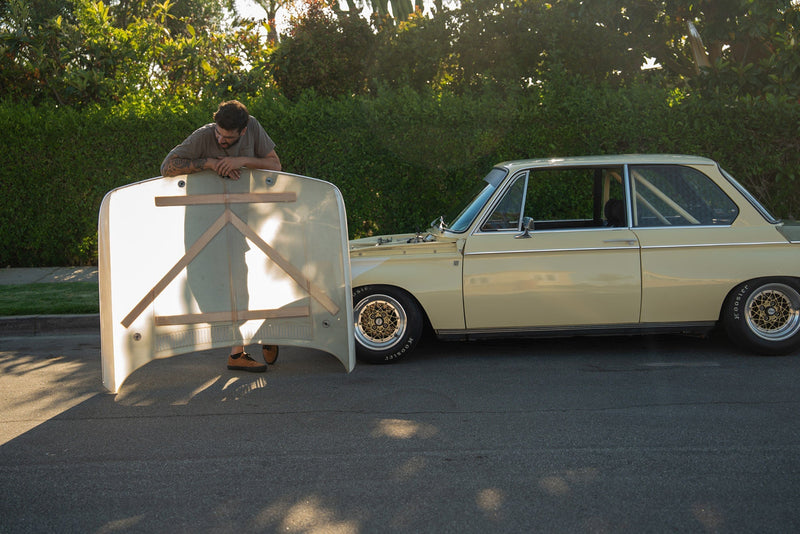I say this not to be unnecessarily braggadocious (okay, maybe a tad), but despite my extensive wheel time variety, I have a shameful confession to make: I haven’t driven many British cars. In fact, I can count on one hand how many classic British sports cars I’ve driven. This is odd because there were millions made, they’re fairly cheap, and I know a lot of people who own them. So, here’s my most recent attempt to make my British car experiences require more than a five finger tally.



This 1974 TVR 2500M belongs to my friend Emil Zuccaro, who purchased the car fromZappa Racing . This mildly modified TVR is a true driver's car: the suspension and drivetrain have been ironed out and everything is in working order. Though the engine has some miles on it, it's still hot and ready for a good time. I told Emil I just loved the looks of this thing, to which he responded, grinning, "It drives even better than it looks."
To try to back that up, Emil threw me the keys and let me wring out this fussy little fiberglass coupe through the Alpine mountainside just east of San Diego. Note: I didn’t drive the hell out a friend’s favorite set of weekend wheels because I wanted to, I did so because he insisted, and he's right: driving this car by the scruff is really the best way to go.


I found this rowdy redcoat does not want to be driven at half speed. It doesn’t like it. It won’t have it. It wants to go fast, even if in reality it can’t go all that fast, it wants to best its attempt at speeding. But that’s not to say this car is slow either—this isn’t some super sensual Jaguar or hoity-toity Rolls. Affordable, fun, and do-it-yourself friendly, this is your average bloke’s British sports car. This car is abastard . It’s a lightweight pub-brawler not afraid to swing above its weight class. On paper, the TVR doesn’t sound all that impressive. 2,000 pounds and 100 tired horsepower aren’t generally figures to fret about, but I quickly learned that my assumption that this car would be a flimsy mess was undeserved. I couldn’t have been more off the mark.


In spite of its lightweight plastic-fantastic construction, the fiberglass hull in tandem with the tube frame chassis is taut. It feels solid… very solid. Shutting the door requires a hefty pull, and the resultant clunk isn’t the chintzy brittle fiber crunch I expected. It not only drives solid, it justfeels that way too. It’s also unique looking and people do take notice. In my rather brief drive, I ran across several perplexed onlookers who were clueless but curious as to what it was. They all looked even more confused when I told them it was a TVR, as if I had just sarcastically made up the name. Uncultured Americans. Being old and British, it’s got some quirks that TVR owners chalk up as charm.



For instance, the front clamshell doesn’t fully open forward unless the front wheels are elevated—though, this is apparently only the case when equipped with this optional wheel and tire combo. Speaking of wheels, how slick are these polished Wolfrace Slot Mag five-spokes? They fit this oh-so-‘70s design so well, and give a stark contrast to the otherwise red and black accented finish.




The profile isn’t the most elegant shape, but its sporty enough, and the fascia more than makes up for any other visual shortcomings. It’s no chipper Austin Healey Sprite’s mug, but its bottom feeder fish face is my favorite aesthetic—it manages to look far wider than it’s actual five-foot-wide track. The lid has a vinyl sunroof insert that is easy to remove for some added airflow, which is certainly welcome with no air conditioning aboard. But the biggest quirk is the massive fishbowl-like rear greenhouse that’d even make the 911 Targa jealous. It’s enormous. Something you really can’t grasp until standing at the ass end of the car peering in through it. I imagine it’s the heaviest panel on the entire car—perhaps its weight is why there’s no rear hatch? It’s also worth mentioning thehood bonnet Naca ducts are functional, as are the gills on the fenders. But enough about its design and awkward aspects, what’s it like to drive?


Well, once you clumsily climb through the microwave-sized door, which Emil admits was easier to enter in his earlier years, you fall into a nicely padded soft bucket. The controls are all right there. The pedal assembly is straight in front of you, not off-center like so many competitors of the era. The steering wheel is worthy of the highest praise—it might not be the most beautiful of all time, but it’d please the Goldilocks bears. It’s not too big, it’s not too small, it’sjussst right. The diameter and thickness of the rim is spot on. There are no fancy grooves or cuts in it either; none of those superficial “performance enhancing” features. It’s just a perfectly sized, perfectly meaty, leather-wrapped wheel. Which brings me to the final touch point: the shifter.

The transmission tunnel is rather tall, so for people with ape arms like myself, your right forearm lies comfortably atop the funky colored carpet. The short lever is topped with awine cork worn wooden knob that is perfectly situated at center. Here's the real shocker: this car has the absolute best shifter I’ve ever had the pleasure to operate—more on that in a minute.
Right before my first go at motion, I jiggle the key into the center console-mounted ignition tumbler, turn over the Triumph-derived 2.5-liter inline-six, and after some time spent whirling the starter and pegging the gas pedal, it fires and sends a bassy idle into the immediate area. After depressing the handbrake’s chrome-topped disengagement cap, I sink the clutch and notch the lever into first. With the slightest application of throttle, the car rolls. Light on its feet, the only time you notice the lack of power steering is from a dig. Moving under load, this car is loud, very loud, but not raspy. It’s more burly—a noise Emil tells me the neighbors love, especially at 7AM like this particular morning.
We poorly attempt to get out of the suburb quietly before hitting the first bends. A series of long, medium-paced turns with blind corners wasn’t where I wanted to open it up, at least not right out of the gate. I take it cautiously. We hit the highway heading towards my planned photo location, and I get it up to speed quickly down the onramp, merge confidently thanks to the nearly unbroken 360-degree visibility, and slot the shifter into 4th.



Emil reminds me that the overdrive is on the column, the first I’ve ever experienced. Sure enough, just below the turn indicator stalk, there’s the overdrive stick. I push it down and the engine drops enough rpm audio toward decibel levels where we can almost chat without shouting at each other—did I mention it’s quite prone to droning?
At this point, I’m still not really comfortable with the controls. Everything seems easy enough to operate, but I’m struggling to make seamless shifts, smooth braking, and linear acceleration. It’s all jumpy and jerky. This is when Emil points out that the car needs to be driven with enthusiasm. Trying to putt around is tricky. Nothing wants to cooperate when driving it lazily.
So, once off the highway, I give it some more throttle, quicken my shifts, and everything magically clicks. It’s as simple as that. As soon as I stopped pussyfooting the car, it behaved. The twin HS-6 SU carbs do not want to be feathered for wheezy hits of oxygen, they want to inhale deeply and deliberately. The carburetors are either on or off; don’t bother with anything in between. Building momentum trough the switchbacks, the steering really comes to life. There’s honest feedback coming through that perfect helm and the car feels secure. Again, I thought this car would be gutless; a flimsy go-kart with floaty feel, but this is not the case.
I may not have driven many British cars, but that doesn’t mean I don’t know what a special one feels like. I’ve driven enough automobiles to differentiate a good one from a bad one and this is one of the better I’ve driven. Not in terms of build quality, though even that’s not bad, and not in terms of sheer speed, though that’s not bad either considering the figures, but as an entire experience. This car bakes the cake, lights the candle for a wish, and lets you eat the whole damn thing.



It’s just the sweetest treat to indulge in, especially that little gear lever. There are no games in the way it shifts, but you have to be intentional in your selection: if you hesitate or shift too slowly, it feels average at best, but when you change gears with gusto it’s the most rewarding stick shift you’ll ever experience. Bold statement, I know. But it’s true. Everything else about the way it drives is splendid as well. The steering is weighted and is a joy to control through that thickset wheel, the brakes work well, and the car accelerates eagerly. Even the noises it makes, while not something you'd want to tolerate everyday, are undeniably amusing. The suspension has a darty feel but it's more fun than hair-raising. But that shifter feeling: it's just the most standout feature on this entire car.
We made it to our photoshoot location, and after 10 minutes parked along the Lake Jennings front road we were booted out by park rangers—but not before they complimented the car. On our way out, two disgusted ladies powerwalked by us, protesting, “Slow down, the speed limit is 15 miles per hour!” Taken back, I look down to the speedometer reading... 15 miles per hour. Apparently the low, loud, and very red sports car appears faster than it is.


So, what have I learned driving a TVR 2500M? Well, for starters, I need to drive more British sports cars. Perhaps they’re not the most reliable and, yes, I did reek of charred oil after a morning drive's-worth of exhaust blow-by wafting into the cabin. But here’s the secret British car guys already know: these cars are relatively inexpensive and, for the money, I’m convinced you’re not going to get more smile-per-dollar in any other classic car segment.
So, if you’re in California and have a classic British sports car you think I need to mull over, you can email me or find me at the next concours—I will likely be in, or trying to sneak into, the cocktail lounge.






















































